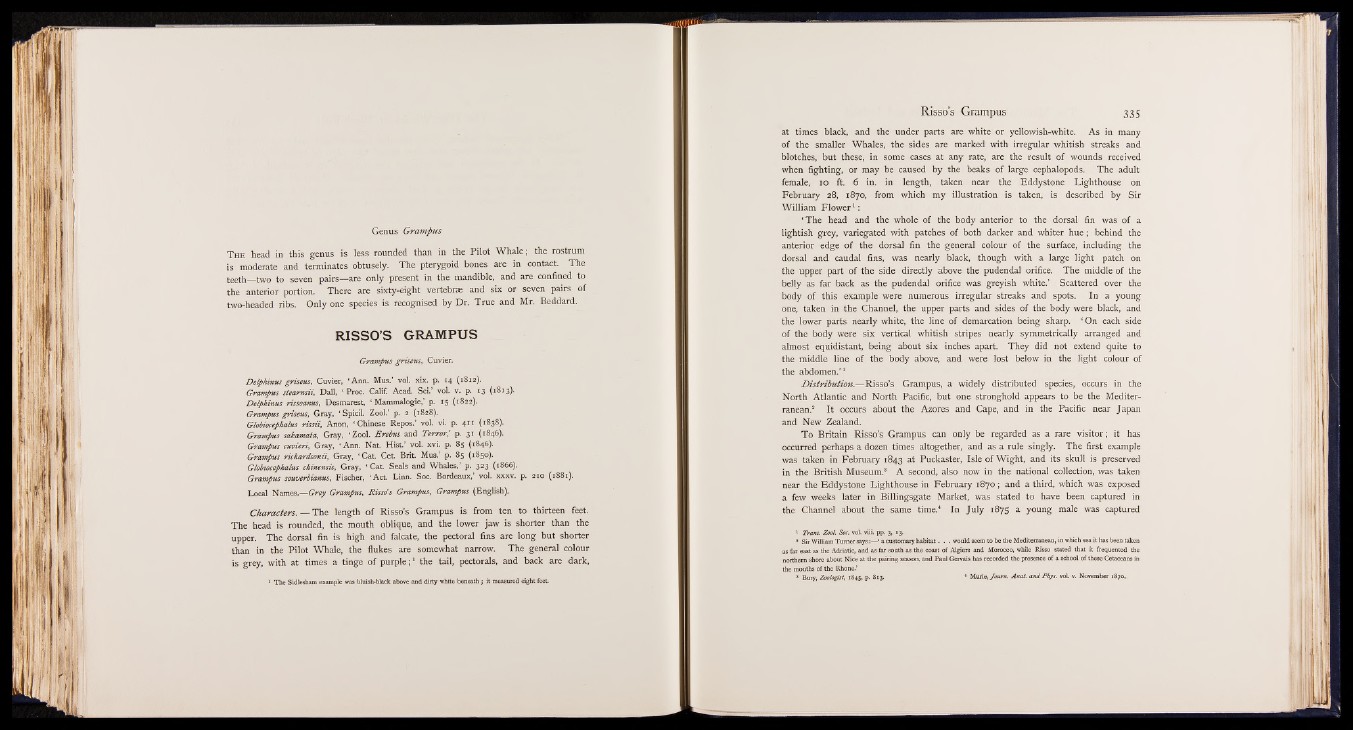
Genus Grampus
T he head in this genus is less rounded than in the Pilot Whale; the rostrum
is moderate and terminates obtusely. The pterygoid bones are in contact. The
teeth— two to seven pairs— are only present in the mandible, and are confined to
the anterior portion. There are sixty-eight vertebrae and, six or seven pairs of
two-headed ribs. Only one species is recognised by Dr. True and Mr. Beddard.
R IS S O ’S G R AM PU S
Grampus griseus, Cuvier.
Delphinus g risetis, Cuvier, ‘ Ann. Mus.’ vol. xix. p. 14 (1812).
Grampus steam sii, Dali, ‘ Proc. Calif. Acad. Sci.’ vol. v. p. 13 (1813).
D elphinus rissoanus, Desmarest, ‘ Mammalogie,’ p. 15 (1822).
Grampus griseus, Gray, ‘ Spicil. Zool.’ p. 2 (1828).
Globiocephalus r issii, Anon, ‘ Chinese Repos.’ vol. vi. p. 411 (1838).
Grampus sakamata, Gray, ‘ Zool. Erebus and Terror,’ p. 31 (1846).
Grampus cuvieri, Gray, ‘ Ann. Nat. Hist.’ vol. xvi. p. 85 (1846).
Grampus richardsonii, Gray, ‘ C a t Cet. Brit. Mus.’ p. 85 (1850).
Globiocephalus chinensis, Gray, ‘ Cat. Seals and Whales,’ p. 323 (1866).
Grampus souverbianus, Fischer, ‘ Act. Linn. Soc. Bordeaux, vol. xxxv. p. 210 (1881).
Local Names.— Grey Grampus, R issd s Grampus, Grampus (English).
Characters. — The length of Risso’s Grampus is from ten to thirteen feet.
The head is rounded, the mouth oblique, and the lower jaw is shorter than the
upper. The dorsal fin is high and falcate, the pectoral fins are long but shorter
than in the Pilot Whale, the flukes are somewhat narrow. The general colour
is grey, with at times a tinge of purple;1 the tail, pectorals, and back are dark,
1 The Sidlesham example was bluish-black above and dirty white beneath; it measured eight feet
Risso’s Grampus 335
at times black, and the under parts are white or yellowish-white. As in many
of the smaller Whales, the sides are marked with irregular whitish streaks and
blotches, but these, in some cases at any rate, are the result of wounds received
when fighting, or may be caused by the beaks of large cephalopods. The adult
female, 10 ft. 6 in. in length, taken near the Eddystone Lighthouse on
February 28, 1870, from which my illustration is taken, is described by Sir
William Flower1 :
‘ The head and the whole of the body anterior to the dorsal fin was of a
lightish grey, variegated with patches of both darker and whiter hue; behind the
anterior edge of the dorsal fin the general colour of the surface, including the
dorsal and caudal fins, was nearly black, though with a large light patch on
the upper part of the side directly above the pudendal orifice. The middle of the
belly as far back as the pudendal orifice was greyish white.’ Scattered over the
body of this example were numerous irregular streaks and spots. In a young
one, taken in the Channel, the upper parts and sides of the body were black, and
the lower parts nearly white, the line of demarcation being sharp. ‘ On each side
of the body were six vertical whitish stripes nearly symmetrically arranged and
almost equidistant, being about six inches apart. They did not extend quite to
the middle line of the body above, and were lost below in the light colour of
the abdomen.’ 1
Distribution.— Risso’s Grampus, a widely distributed species, occurs in the
North Atlantic and North Pacific, but one stronghold appears to be the Mediterranean.
2 It occurs about the Azores and Cape, and in the Pacific near Japan
and New Zealand.
To Britain Risso’s Grampus can only be regarded as a rare visitor; it has
occurred perhaps a dozen times altogether, and as a rule singly. The first example
was taken in February 1843 at Puckaster, Isle of Wight, and its skull is preserved
in the British Museum.8 A second, also now in the national collection, was taken
near the Eddystone Lighthouse in February 1870; and a third, which was exposed
a few weeks later in Billingsgate Market, was stated to have been captured in
the Channel about the same time.4 In July 1875 a young male was captured
1 Trans. Zool. Soc. vol. viii. pp. 3, 13.
* Sir William Turner says:— ‘ a customary habitat. . . would seem to be the Mediterranean, in which sea it has been taken
as far east as the Adriatic, and as far south as the coast of Algiers and Morocco, while Risso stated that it frequented the
northern shore about Nice at the pairing season, and Paul Gervais has recorded the presence of a school of these Cetaceans in
the mouths of the Rhone.’
3 Bury, Zoologist, 1845, p. 813. 4 Murie, Joum. Anal, and Phys. vol. v. November 1870,